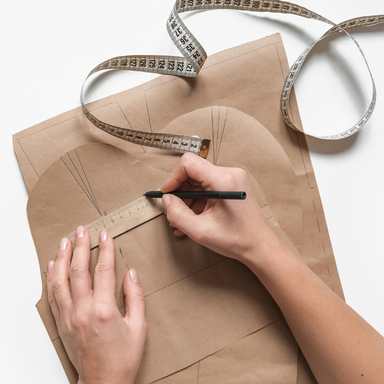Posted by Wicked Fabrics - Vivi Richards on 29th Jun 2024
Zero to Little Waste Sewing Methodology
Read Time: 3m
Zero-waste sewing is a concept that aligns perfectly with my values of sustainability. It's all about maximising the use of your fabric, leaving behind little to no waste. Here's how to get started so you're on your way to working towards that goal:
Pattern Efficiency: Choosing sewing patterns designed for minimal fabric waste is paramount. Look for patterns specifically labelled as "zero-waste" or "minimal waste." These patterns are thoughtfully crafted to fit together like a puzzle, ensuring that every inch of fabric is utilised. Some designers offer downloadable patterns that can be printed at home and pieced together, allowing you to see exactly how the fabric will be used. When cutting your fabric, take the time to lay out all pattern pieces in a way that minimises gaps and overlaps.
Fabric Scraps: Don't underestimate the potential of fabric scraps! Save even the tiniest pieces as they can be incredibly useful. Small scraps can be transformed into beautiful embellishments, appliqués, or even used in quilting or mixed fabric projects. Consider starting a scrap bin where you collect these remnants. Over time, you'll accumulate a diverse array of materials that you can draw inspiration from. Embracing a creative mindset will help you see the potential in every piece of fabric.
Fabric Folding Techniques: Explore advanced techniques such as "fabric folding" or "zero-waste draping" to design garments that make use of the entire fabric piece without waste. Fabric folding involves strategically folding the fabric before cutting, allowing you to create unique shapes and designs that use the entire width and length of the material. Zero-waste draping, on the other hand, involves draping the fabric directly on a dress form and designing the garment in a way that ensures no fabric is wasted. This method often results in innovative and one-of-a-kind pieces that are not only sustainable but also fashion-forward.
Upcycling Old Fabrics: Give New Life to the Old
Upcycling is the art of transforming old garments or fabrics into something fresh and fashionable. It's a sustainable way to reduce textile waste and infuse your wardrobe with unique, personalized pieces. Here’s how to upcycle effectively:
Thrift Store Finds: Search for interesting fabrics in thrift stores (such as Salvos Store or Vinnies) or even your own closet. Thrift stores are treasure troves of unique fabrics, often at a fraction of the cost of new materials. Look for garments with large, unblemished sections of fabric that can be repurposed. Vintage pieces, in particular, can offer high-quality materials and unique patterns that are hard to find in new fabrics. Don't forget to check out items like bed linens, curtains, and tablecloths, which can provide large amounts of fabric.
Deconstruction: Carefully take apart old garments to salvage fabric and notions. Use a seam ripper to dismantle seams without damaging the fabric. Be sure to assess the fabric's condition before starting; check for wear, stains, or weakened fibres. Once deconstructed, wash and press the fabric to prepare it for its new purpose. Salvage buttons, zippers, and other notions that can be reused in future projects. This meticulous process not only provides you with usable fabric but also enhances your understanding of garment construction.
Creative Patchwork: Combine different fabric scraps into a beautiful patchwork design. Patchwork isn’t just for quilts; it can be a fantastic way to create unique fashion statements. Use a mix of textures, colours, and patterns to craft one-of-a-kind garments such as patchwork dresses, cardigans, and sweaters. Experiment with different patchwork techniques, like traditional quilting blocks or more abstract, freeform designs. Patchwork can also be used for accessories like bags, scarves, and hats, or even home decor items like cushion covers and wall hangings.
At Wicked Fabrics, I believe that eco-friendly sewing practices are a crucial part of the slow fashion movement. By embracing these suggestions, you're not only reducing your environmental footprint but also adding a unique, personal touch to your creations. Join me in making every stitch a sustainable one and sewing a better, greener future for all.
Ready to start your eco-friendly sewing journey? Explore our sustainable fabric collections and let your creativity bloom with a conscience.



